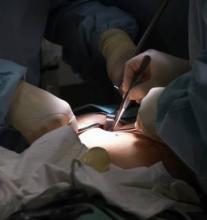In an urban colorectal surgery department, a near-doubling in the proportion of surgical procedures performed laparoscopically accompanied significant declines in both severe postoperative morbidity and conversions to laparotomy, in a 14-year, single-hospital study reported in Annals of Surgery.
"This study demonstrated that a laparoscopic approach is a safe and effective alternative to open surgery" for management of inflammatory bowel disease (IBD), wrote Dr. León Maggiori and his associates at the Assistance Publique-Hôpitaux de Paris.
"Associated postoperative morbidity was comparable to reported rates after open approach," the researchers added.
Dr. Maggiori and his associates studied 790 consecutive intestinal resections for IBD performed on 633 patients between June 1998 and July 2012. About two-thirds of the procedures were for Crohn’s disease, and one-third were for ulcerative colitis, the investigators said (Ann. Surg. 2014;260:305-10). The proportion of laparoscopically performed procedures rose from 42% to 80% during the study period (P less than .001), and the trend occurred both for Crohn’s and for ulcerative colitis cases, they added.
As surgeons accrued experience, the rate of complex cases performed laparoscopically also approximately doubled (from 16% to 33%; P less than .023), the researchers said. Furthermore, the mean adjusted risk of conversion to open surgery fell significantly (from 18% to 6%; P less than .001), as did the rate of severe postoperative morbidity (from 14% to 8%; P less than .001).
In all, 12% of laparoscopic cases required conversion, most often because of abscesses or fistulas found during surgery or difficulty dissecting adhesions, the investigators said. Thirteen percent of laparoscopies led to severe postoperative morbidity, defined as Clavien-Dindo grade 3 or 4 complications, they added. The single postoperative death occurred in a patient who developed peritonitis and septic shock 3 days after laparoscopic colectomy with ileosigmoidostomy, the researchers said.
The hospital now uses laparoscopy as the standard approach for surgical management of IBD, except in cases of complicated acute colitis, Dr. Maggiori and his associates said.
The limited number of straight open surgical cases meant that they could not directly be compared with laparoscopy, said the investigators, adding that they lacked data on long-term outcomes because many patients underwent surgery in 2008 or later.
The Association François Aupetit partially funded the study. The authors reported having no conflicts of interest.

